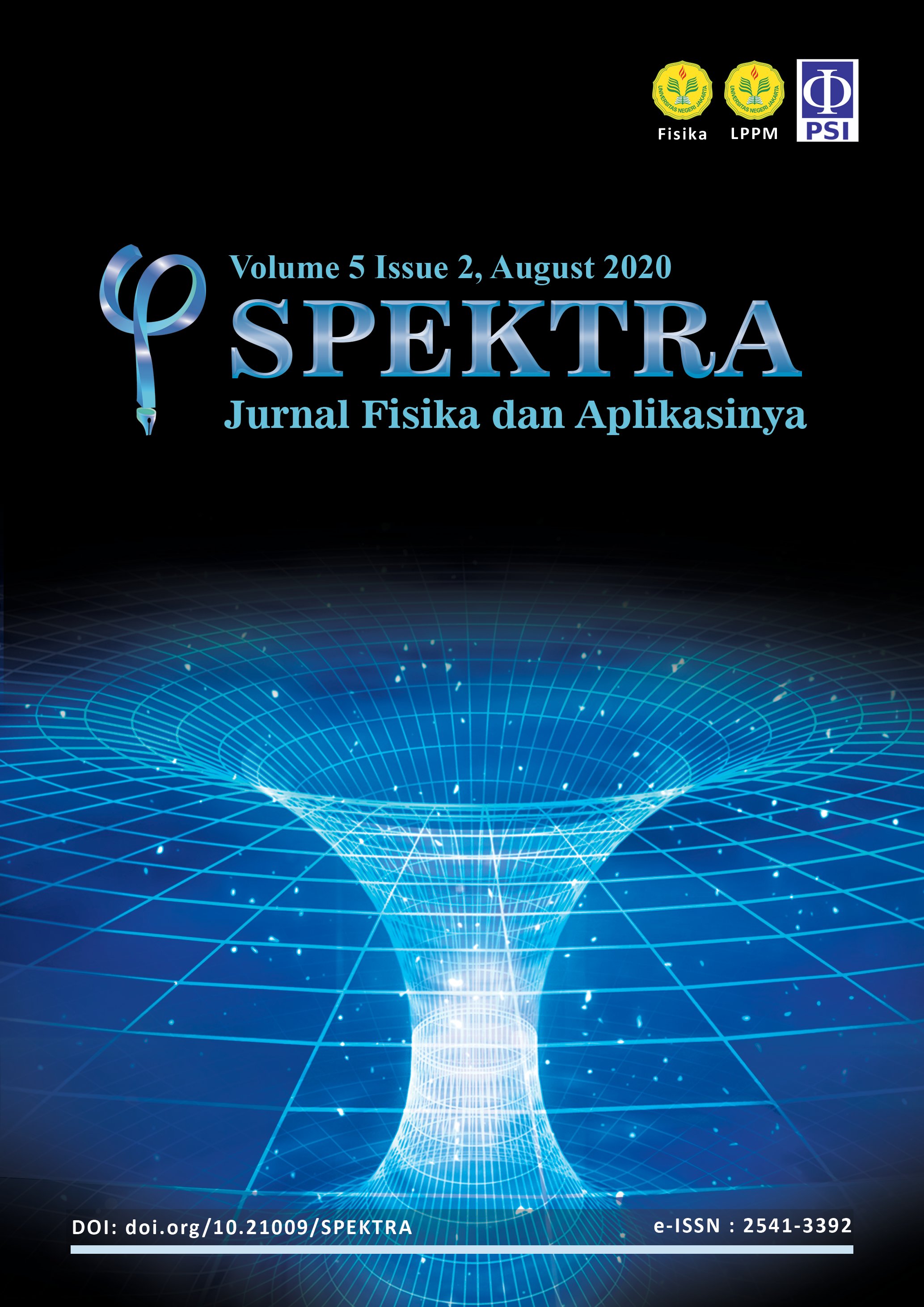THE STABILITY STUDIES OF MIXED HALIDE PEROVSKITE CH3NH3PbBrXI3-X THIN FILMS IN AMBIENT WITH AIR HUMIDITY 70% USING UV-VIS SPECTROSCOPY AND X-RAY DIFFRACTION
DOI:
https://doi.org/10.21009/SPEKTRA.052.03Keywords:
mixed halide perovskite, absorption spectra, crystal structure, humidity, stabilityAbstract
Perovskite Solar Cells (PSC), with the efficiency of more than 22%, has shown promising prospects for the future of environmentally friendly technology. However, low stability on humidity is a major problem limiting the commercialization of PSC. The perovskite material commonly used as a perovskite solar-cell active material is methylammonium lead tri-iodide (CH3NH3PbI3 or MAPbI3) prepared with a mixture of methylammonium-iodide (MAI) and lead iodide (PbI2). Perovskite material MAPbI3 is hygroscopic and easily decomposed into its constituent material, thereby reducing the performance of the PSC. Meanwhile, perovskite methylammonium lead-bromide (MAPbBr3) has higher moisture stability than MAPbI3 because it has a cubic crystal structure that has high symmetry. However, the efficiency of solar cells using MAPbBr3 as active material is lower than that of MAPbI3, due to a higher bandgap (~2.2 eV) than that of MAPbI3 (~1.5 eV). Therefore the wavelength range of sunlight absorbed by MAPbBr3 is shorter. We have studied the effect of the ratio of Bromium ion (Br-) insertion into MAPbI3 perovskite, forming mixed perovskite halide MAPbBrxI3-x on the stability of thin perovskite films in ambient with air humidity 70%. The value of x is varied from x = 0, 0.25, 0.5, 0.75 and 3. We measured the evolution of UV-Vis spectra and XRD patterns of thin perovskite films. The MAPbBr3 perovskite film is the most stable in high air relative humidity (> 70%). While mixed perovskite films with x = 0.5 are more stable as compared to the other x values based on absorption spectra. The XRD results showed that the stability of mixed halide perovskite is decreased with the increasing of x value.
References
[2] W. S. Yang et al., “Iodide management in formamidinium-lead-halide-based perovskite layers for efficient solar cells,” Science, 2017, vol. 356.
[3] E. Köhnen et al., “Highly efficient monolithic perovskite silicon tandem solar cells: analyzing the influence of current mismatch on device performance,” Sustain. Energ. Fuels, 2019, vol. 3.
[4] J. Burschka et al., “Sequential deposition as a route to high-performance perovskite-sensitized solar cells,” Nature, 2013, vol. 499.
[5] J. Noh et al., “Chemical management for colorful, efficient, and stable inorganic–organic hybrid nanostructured solar cells,” Nano Lett., 2013, vol. 13.
[6] N. J. Jeon et al., “Compositional engineering of perovskite materials for high-performance solar cells,” Nature, 2016, vol. 517.
[7] Y. Rong et al., “Beyond efficiency: the challenge of stability in mesoscopic perovskite solar cells,” Adv. Energy Mater., 2015, vol. 5.
[8] L. Meng, J. You and Y. Yang, “Addressing the stability issue of perovskite solar cells for commercial applications,” Nat. Commun., 2018, vol. 9.
[9] J. Yang, B. D. Siempelkamp and D. Liu, “Investigation of CH3NH3PbI3 degradation rates and mechanisms in controlled humidity environments using in situ techniques,” ACS Nano, 2015, vol. 9.
[10] T.A. Berhe at al., “Organometal halide perovskite solar cells: degradation and stability,” Energ. Environ. Sci., 2016, vol. 9.
[11] F. Brivio, J. M. Frost and J. M. Skelton, “Lattice dynamics and vibrational spectra of the orthorhombic, tetragonal, and cubic phases of methylammonium lead iodide,” Phy. Rev. B, 2015, vol. 92.
[12] K. Habibie, N. A. Syifa and A. Bahtiar,”Pengaruh penyisipan ion bromida terhadap sifat optik dan struktur kristal lapisan tipis perovskite halida campuran MAPbBrXI3-X,” Jurnal Material dan Energi Indonesia, 2019, vol. 09.
[13] L. Atourki et al., “Role of the chemical substitution on the structural and luminescence properties of the mixed halide perovskite thin MAPbI3−XBrX (0 ≤ x ≤ 1) films”, App. Surf. Sc., 2016, vol. 371.
[14] A. Bahtiar, S. Rahmanita and Y. D. Inayatie, “Pin-hole free perovskite film for solar cells application prepared by controlled two-step spin-coating method”, IOP Conf. Ser.: Mater. Sci. Eng., 2017, vol.196.
[15] K. H. Wang, L. C. Li, M. Shellaiah and Kien Wen Sun, “Structural and photophysical properties of methylammonium lead tribromide (MAPbBr3) single crystals”, Sci. Rep., 2017, vol. 7.
Downloads
Published
How to Cite
Issue
Section
License
SPEKTRA: Jurnal Fisika dan Aplikasinya allow the author(s) to hold the copyright without restrictions and allow the author(s) to retain publishing rights without restrictions. SPEKTRA: Jurnal Fisika dan Aplikasinya CC-BY or an equivalent license as the optimal license for the publication, distribution, use, and reuse of scholarly work. In developing strategy and setting priorities, SPEKTRA: Jurnal Fisika dan Aplikasinya recognize that free access is better than priced access, libre access is better than free access, and libre under CC-BY or the equivalent is better than libre under more restrictive open licenses. We should achieve what we can when we can. We should not delay achieving free in order to achieve libre, and we should not stop with free when we can achieve libre.
 SPEKTRA: Jurnal Fisika dan Aplikasinya is licensed under a Creative Commons Attribution 4.0 International License.
SPEKTRA: Jurnal Fisika dan Aplikasinya is licensed under a Creative Commons Attribution 4.0 International License.
You are free to:
Share - copy and redistribute the material in any medium or format
Adapt - remix, transform, and build upon the material for any purpose, even commercially.
The licensor cannot revoke these freedoms as long as you follow the license terms.

 E-ISSN 2541-3392
E-ISSN 2541-3392  Focus & Scope
Focus & Scope  Editorial Team
Editorial Team  Reviewer Team
Reviewer Team  Author Guidelines
Author Guidelines  Article Template
Article Template  Author Fee
Author Fee  Publication Ethics
Publication Ethics  Plagiarism Policy
Plagiarism Policy  Open Access Policy
Open Access Policy  Peer Review Process
Peer Review Process  Retraction & Correction
Retraction & Correction  Licensing & Copyright
Licensing & Copyright  Archiving & Repository
Archiving & Repository  Contact
Contact  Mendeley
Mendeley 

